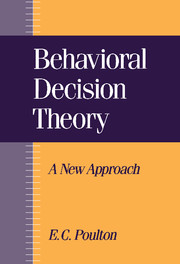Crossref Citations
This Book has been
cited by the following publications. This list is generated based on data provided by Crossref.
Bolger, Fergus
and
Harvey, Nigel
1995.
Judging the probability that the next point in an observed time‐series will be below, or above, a given value.
Journal of Forecasting,
Vol. 14,
Issue. 7,
p.
597.
Pham, Michel Tuan
1996.
Heuristiques et biais décisionnels en marketing.
Recherche et Applications en Marketing (French Edition),
Vol. 11,
Issue. 4,
p.
53.
West, Richard F.
and
Stanovich, Keith E.
1997.
The domain specificity and generality of overconfidence: Individual differences in performance estimation bias.
Psychonomic Bulletin & Review,
Vol. 4,
Issue. 3,
p.
387.
Stocké, Volker
1998.
Anomalien in Handlungs- und Entscheidungstheorien.
p.
197.
Stanovich, Keith E.
and
West, Richard F.
1998.
Who uses base rates andP(D/∼H)? An analysis of individual differences.
Memory & Cognition,
Vol. 26,
Issue. 1,
p.
161.
Metcalfe, Janet
1998.
Cognitive Optimism: Self-Deception or Memory-Based Processing Heuristics?.
Personality and Social Psychology Review,
Vol. 2,
Issue. 2,
p.
100.
Fischhoff, Baruch
and
Bruine De Bruin, Wändi
1999.
Fifty-Fifty=50%?.
Journal of Behavioral Decision Making,
Vol. 12,
Issue. 2,
p.
149.
McFadden, Daniel
Machina, Mark J.
and
Baron, Jonathan
1999.
Elicitation of Preferences.
p.
73.
Kalafatis, Stavros P.
Tsogas, Markos H.
and
Blankson, Charles
2000.
Positioning strategies in business markets.
Journal of Business & Industrial Marketing,
Vol. 15,
Issue. 6,
p.
416.
Roosenburg, Willem M.
2000.
Hypothesis Testing, Decision Theory, and Common Sense in Resource Management.
Conservation Biology,
Vol. 14,
Issue. 4,
p.
1208.
Harvey, Nigel
2001.
Principles of Forecasting.
Vol. 30,
Issue. ,
p.
59.
Gilovich, Thomas
Griffin, Dale
and
Kahneman, Daniel
2002.
Heuristics and Biases.
Bruine de Bruin, Wändi
Fischbeck, Paul S.
Stiber, Neil A.
and
Fischhoff, Baruch
2002.
What Number is “Fifty‐Fifty”?: Redistributing Excessive 50% Responses in Elicited Probabilities.
Risk Analysis,
Vol. 22,
Issue. 4,
p.
713.
Stalmeier, Peep F. M.
Busschbach, Jan J. V.
Lamers, Leida M.
and
Krabbe, Paul F. M.
2005.
The gap effect: discontinuities of preferences around dead.
Health Economics,
Vol. 14,
Issue. 7,
p.
679.
Mandel, David R.
2005.
Are Risk Assessments of a Terrorist Attack Coherent?.
Journal of Experimental Psychology: Applied,
Vol. 11,
Issue. 4,
p.
277.
TAKEMURA, Kazuhisa
2005.
Decision Making and Behavioral Decision Theory.
Journal of Japan Society for Fuzzy Theory and Intelligent Informatics,
Vol. 17,
Issue. 6,
p.
646.
Shaban, Ramon Z.
2005.
Theories of Clinical Judgment and Decision-Making: A Review of the Theoretical Literature.
Australasian Journal of Paramedicine,
Vol. 3,
Issue. ,
p.
1.
Harvey, Nigel
2007.
Use of heuristics: Insights from forecasting research.
Thinking & Reasoning,
Vol. 13,
Issue. 1,
p.
5.
Tsoukiàs, Alexis
2007.
On the concept of decision aiding process: an operational perspective.
Annals of Operations Research,
Vol. 154,
Issue. 1,
p.
3.
Cahan, Sorel
and
Snapiri, Tchia
2008.
Intuitive prediction: ecological validity versus representativeness.
Journal of Behavioral Decision Making,
Vol. 21,
Issue. 3,
p.
297.



